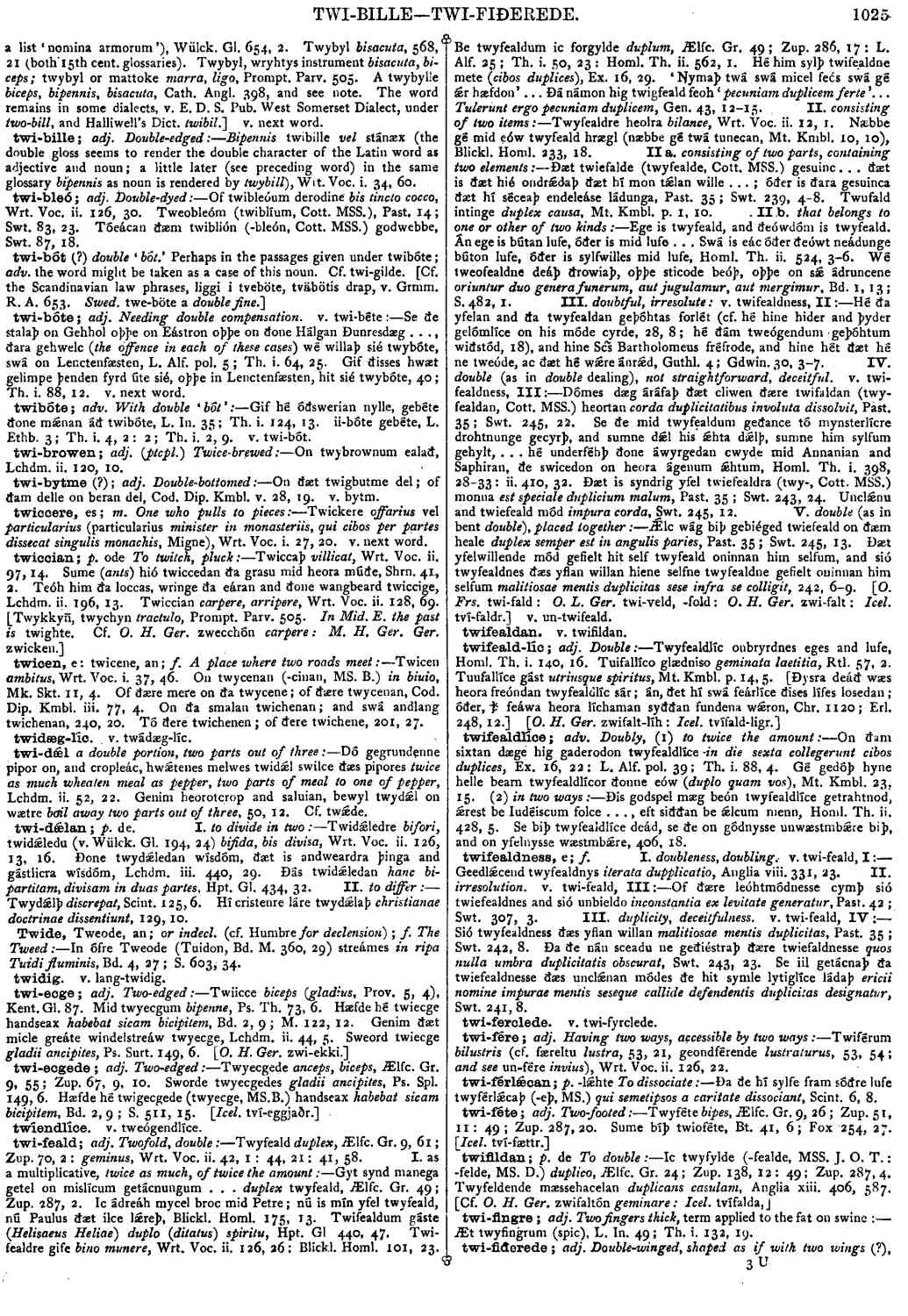twi-feald
- numeral
- adjective
-
Twyfeald duplex, Ælfc. Gr. 9, 61; Zup. 70, 2 :
geminus
,- Wrt. Voc. ii. 42, l : 44, 21:
41, 58.
-
Gyt synd manega getel on mislícum getácnungum . . .
duplex
twyfeald,- Ælfc. Gr. 49; Zup.
287, 2.
-
Ic ádreáh mycel broc mid Petre; nú is mín yfel twyfeald, nú Paulus ðæt ilce lǽreþ,
- Blickl. Homl. 175, 13.
-
Twifealdum gáste
(Helisaeus Helia) duplo (dilatuj) spiritu
,- Hpt. Gl 440, 47.
-
Twi-fealdre gife
bino munere,
- Wrt. Voc. ii. 126, 26: Blickl. Homl. 101, 23.
-
Be twyfealdum ic forgylde duplum, Ælfc. Gr. 49; Zup. 286, 17 : L. Alf. 25 ; Th. i. 50, 23 : Homl. Th. ii. 562, l. Hé him sylþ twifealdne mete (cibos duplices), Ex. 16, 29. 'Nymaþ twá swá micel fećs swá gé ǽer hæfdon'. . . Ðá námon hig twigfeald feoh
'pecuniam duplicem ferte'. . . Tulerunt ergo pecuniam duplicem,
- Gen. 43, 12-15.
-
Twyfealdre heolra bilance, Wrt. Voc. ii. 12, i. Næbbe gé mid eów twyfeald hrægl (næbbe gé twá tunecan, Mt. Kmbl. 10, 10), Blickl. Homl. 233, 18. II a.
consisting of two parts, containing two elements
:-- Ðæt twiefalde (twyfealde,- Cott. MSS.) gesuinc. . .
-
Twufald intinge duplex causa. Mt. Kmbl. p. I. 10. IIb.
that belongs to one or other of two kinds
:-- Ege is twyfeald, and ðeówdóm is twyfeald. Án ege is bútan lufe, óðer is mid lufe. . . Swá is eác óðer ðeówt neádunge búton lufe, óðer is sylfwilles mid lufe,- Homl. Th. ii. 524, 3-6.
-
Wé tweofealdne deáþ ðrowiaþ, oþþe sticode beóþ, oþþe on sǽ ádruncene
oriuntur duo genera funerum, aut jugulamur, aut mergimur.
- Bd. l, 13; 8. 482, l.
-
Hé ða yfelan and ða twyfealdan geþóhtas forlét (cf. hé hine hider and þyder gelómlíce on his móde cyrde,
- 28, 8; hé ðám tweógendum geþóhtum wiðstód, 18), and hine S
Bartholomeus fréfrode, and hine hét ðæt hé ne tweóde, ac ðæt hé wǽre ánrǽd,
Guthl. 4; Gdwin. 30, 3-7.
-
Dómes dæg áráfaþ ðæt cliwen ðære twifaldan (twy-fealdan, Cott. MSS.) heortan
corda duplicitatibus involuta dissolvit
,- Past. 35 ; Swt. 245, 22.
-
Se ðe mid twyfealdum geðance tó mynsterlícre drohtnunge gecyrþ, and sumne dǽl his ǽhta dǽlþ, sumne him sylfum gehylt, . . . hé underféhþ ðone áwyrgedan cwyde mid Annanian and Saphiran, ðe swicedon on heora ágenum ǽhtum,
- Homl. Th. i. 398, 28-33 : ii. 410, 32.
-
Ðæt is syndrig yfel twiefealdra (twy-, Cott. MSS.) monna
est speciale duplicium malum,
- Past. 35 ; Swt. 243, 24.
-
Unclǽnu and twiefeald mód
impura corda,
- Swt. 245, 12.
-
Ǽlc wág biþ gebiéged twiefeald on ðæm heale
duplex semper est in angulis paries
,- Past. 35; Swt. 245, 13.
-
Ðæt yfelwillende mód gefielt hit self twyfeald oninnan him selfum, and sió twyfealdnes ðæs yflan willan hiene selfne twyfealdne gefielt ouinnan him selfum
malitiosae mentis duplicitas sese infra se colligit
,- 242, 6-9.
Bosworth, Joseph. “twi-feald.” In An Anglo-Saxon Dictionary Online, edited by Thomas Northcote Toller, Christ Sean, and Ondřej Tichy. Prague: Faculty of Arts, Charles University, 2014. https://bosworthtoller.com/31254.
Checked: 0